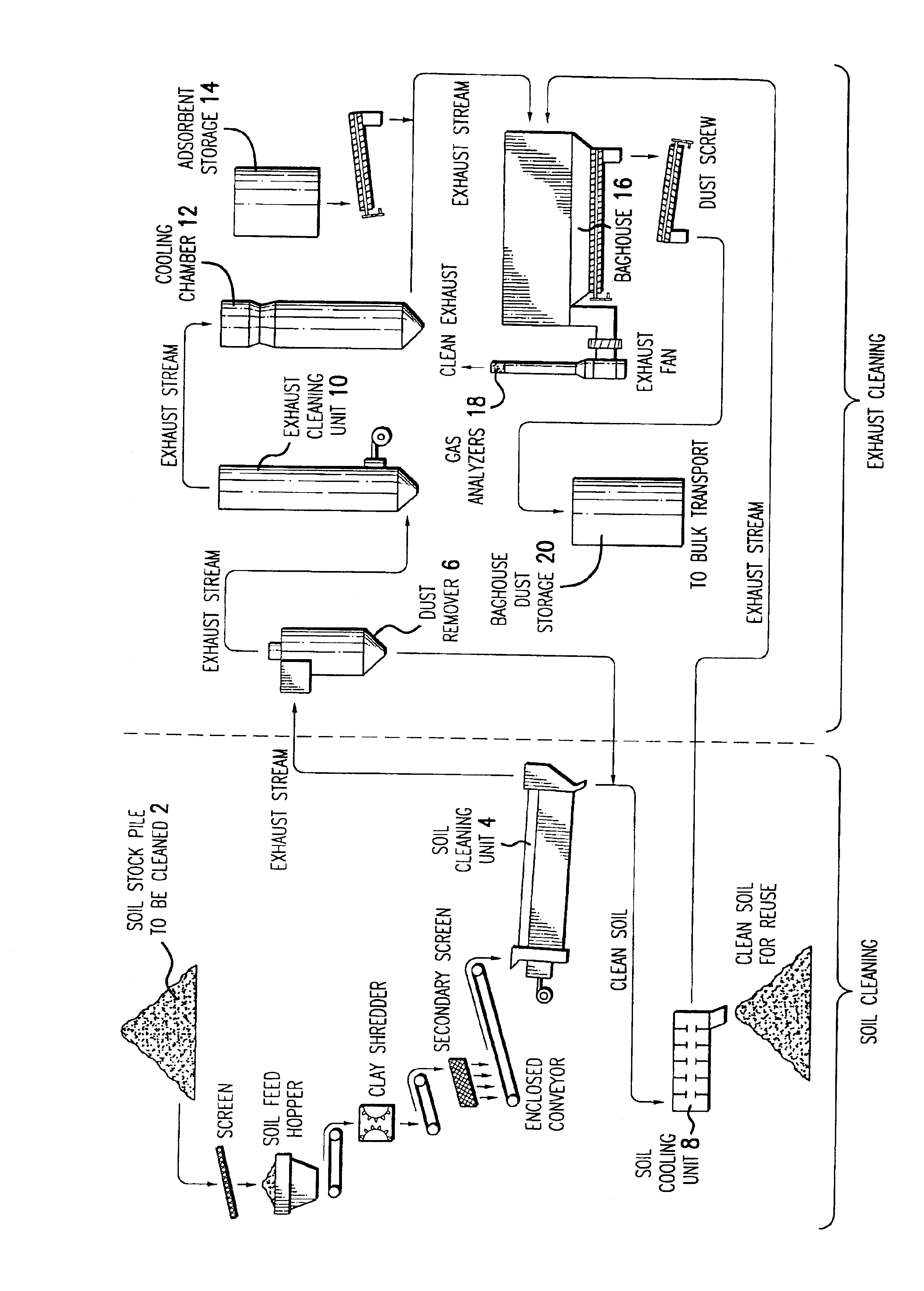Adsorption powder containing cupric chloride
a technology of cupric chloride and adsorption powder, which is applied in the direction of physical/chemical process catalysts, other chemical processes, separation processes, etc., can solve the problems of increasing the difficulty of removing mercury from gaseous streams, increasing the difficulty of removing mercury, and unable to efficiently remove mercury from vaporous streams with current technology
- Summary
- Abstract
- Description
- Claims
- Application Information
AI Technical Summary
Benefits of technology
Problems solved by technology
Method used
Image
Examples
example 1
Two different solid phase samples of soils were utilized to determine the effectiveness of the adsorption powder and method of the invention. The first soil (soil A) contained about 4 parts per million (ppm) of mercury, and the second soil (soil B) contained about 14 ppm of mercury. Each sample was screened to 1-inch utilizing the appropriate mesh screen. The coarse material (above 1-inch average diameter) were removed from the samples and discarded. Portions of the samples passing through the 1-inch screen were divided into several 1 kg charges. Each charge was homogenized to assure equal distribution of mercury within the soil matrix as well as to eliminate any “hot spots” therein. The homogenized samples were inserted into glass tubes that were heated to a temperature of about 900° F. using an indirect, electrically, heating oven. During the heating process, the glass tubes were continuously rotated inside the oven to closely resemble a rotary kiln of an LTTD unit. Generally, aft...
example 2
Table 2 provides a carbon-based, adsorption powder, Sorbalite, containing carbon, calcium hydroxide and sulfur components in the listed percentages utilized in the process for Run Nos. 1 through 3. In Run Nos. 4 through 15, 1 to 10 weight % of cupric(II)chloride, based on a total of 100 weight percent of the Sorbalite, was added to the powder composition.
TABLE 2RunAdsorbent PowderHg In,Hg Out,EffcMassTemp,Water,#Componentsmgmg%Bal, %° F.wt %138% C + 58% Ca(OH)2 + 4% S3.50.82276.51933000.01238% C + 58% Ca(OH)2 + 4% S3.61.266.67573000.01338% C + 58% Ca(OH)2 + 4% S2.70.966.67844000.504[38% C + 58% Ca(OH)2 + 4% S] +1.40.6593.572194000.503% CuCl25[38% C + 58% Ca(OH)2 + 4% S] +2.02*0.30185.001014000.501% CuCl26[38% C + 58% Ca(OH)2 + 4% S] +2.460.08796.4683.903000.015% CuCl27[38% C + 58% Ca(OH)2 + 4% S] +1.840.00999.51963000.015% CuCl28[38% C + 58% Ca(OH)2 + 4% S] +1.750.01499.20863000.015% CuCl29[38% C + 58% Ca(OH)2 + 4% S] +1.940.06796.551033000.015% CuCl210[38% C + 58% Ca(OH)2 + 4% S] +...
example 3
Table 3 provides the composition of an adsorption powder containing carbon, calcium hydroxide and potassium permanganate components in the listed percentages utilized in the process for Run Nos. 1 through 3. In Run Nos. 4 and 5, 5 weight % of cupric(II)chloride, based on 100 total weight percent of the carbon-based powder, was added to the powder composition.
TABLE 3RunAdsorbent PowderHg In,Hg Out,EffcMassTempWater#Componentsmgmg%Bal, %° F.wt %134% C + 52% Ca(OH)2 + 4% S +2.040.3881.34653000.0110% KMnO4234% C + 52% Ca(OH)2 + 4% S +1.920.43977.14924000.5010% KMnO4334% C + 52% Ca(OH)2 + 4% S +1.850.3382.161043000.0110% KMnO44[34% C + 52% Ca(OH)2 + 4% S +2.40.0299.17903000.0110% KMnO4] + 5% CuCl25[34% C + 52% Ca(OH)2 + 4% S +2.90.1993.451194000.5010% KMnO4] + 5% CuCl2
PUM
| Property | Measurement | Unit |
|---|---|---|
| Percent by mass | aaaaa | aaaaa |
| Percent by mass | aaaaa | aaaaa |
| Percent by mass | aaaaa | aaaaa |
Abstract
Description
Claims
Application Information
 Login to View More
Login to View More - R&D
- Intellectual Property
- Life Sciences
- Materials
- Tech Scout
- Unparalleled Data Quality
- Higher Quality Content
- 60% Fewer Hallucinations
Browse by: Latest US Patents, China's latest patents, Technical Efficacy Thesaurus, Application Domain, Technology Topic, Popular Technical Reports.
© 2025 PatSnap. All rights reserved.Legal|Privacy policy|Modern Slavery Act Transparency Statement|Sitemap|About US| Contact US: help@patsnap.com

